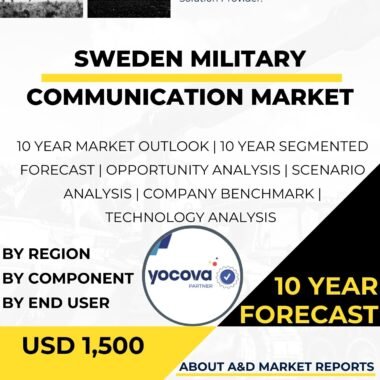Description
Overview of the Australia Military Communication Market
The Australia Military Communication Market is a vital and fast-growing part of the country’s defense sector. Military communication systems support the Australian Defense Force (ADF) by providing secure, reliable, and fast communication channels. These systems improve command, control, and coordination during missions. They also strengthen situational awareness and help the ADF maintain a tactical edge on the battlefield.
Command and Control in the Australia Military Communication Market
A key role of military communication systems in Australia is to support command and control operations. These systems enable real-time communication between commanders and troops. Clear and secure communication helps transfer orders quickly, which is essential during fast-moving operations. Strong command and control improves mission success and enhances battlefield coordination.
Interoperability Across the Australia Military Communication Market
The Australia Military Communication Market also focuses on interoperability. Modern systems allow seamless communication among different branches of the ADF. They also support communication with allied forces during joint missions. This compatibility strengthens partnerships and improves Australia’s ability to take part in multinational operations.
Secure Communication and Cyber Protection
Military communication systems help protect sensitive data in contested environments. Adversaries now use electronic warfare and cyberattacks to disrupt networks. Because of this, secure and encrypted communication is essential. Strong cybersecurity ensures that communication networks remain protected from unauthorized access.
Situational Awareness in the Australia Military Communication Market
Another major benefit of these systems is improved situational awareness. Military communication technologies support the collection and sharing of intelligence. Real-time information helps personnel make accurate decisions. Better awareness increases mission success and enhances the safety of deployed forces.
Key Market Drivers
The Australia Military Communication Market is growing due to the need to modernize outdated networks and integrate new technologies. As warfare becomes more advanced and data-driven, the ADF must upgrade its communication capabilities. Investment in advanced systems ensures readiness and strengthens national security.
Research, Innovation, and Collaboration
Partnerships between defense industries and academic institutions support innovation in the Australia Military Communication Market. These collaborations help develop new communication technologies, improved networking solutions, and advanced encryption methods. This teamwork ensures that the ADF benefits from the latest advancements.
Policy and Procurement Support
Government policy and defense procurement decisions have a major impact on market growth. Long-term funding for research, development, and system acquisition is essential. Consistent support allows Australia to maintain technological superiority and meet emerging operational needs.
Cybersecurity in the Australia Military Communication Market
Strong cybersecurity is critical for all modern communication networks. As the ADF adopts more digital and interconnected systems, protecting them from cyber threats becomes even more important. Secure systems prevent hacking attempts and ensure uninterrupted communication during operations.
Conclusion
In summary, the Australia Military Communication Market is a vital and fast-evolving sector. Advanced communication systems give the ADF secure and efficient channels that support command and control, enhance situational awareness, and enable cooperation with allied forces.
By investing in modern technologies, encouraging research partnerships, and strengthening cybersecurity, Australia can continue to improve its defense communication capabilities. These systems will remain essential for supporting military operations and ensuring readiness for future security challenges.




